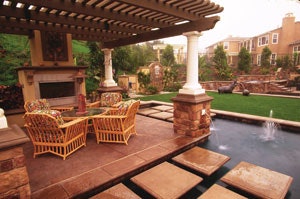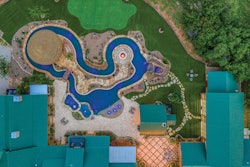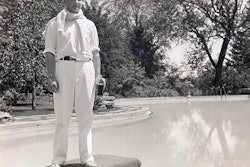
The term patio is decidedly unhip these days. Now it's all about creating an outdoor experience that's an extension of the indoors, far surpassing the days of strappy aluminum folding chairs decorated with towels and a book. The backyard of the new millennium isn't just an area to hang out anymore; it's a lifestyle, and it takes professionals to make it work.
In And/Or Out
Whether using a designer specific to the outdoors, like The Green Scene, or calling on interior designers to get the job done, picking furniture, fabrics, colors and coordinating bits and pieces takes more than attention to detail.
"A lot of people don't realize how sophisticated outdoor living furniture has become," says Steve Bishop, general manager of the Boca Raton, Fla., Robb & Stucky Outdoor Living store, "so they don't know how to resource it or where to go.
"Bring an interior designer in. They know all the different manufacturers, they know what all the products are; they can resource all the different fabrics, the different colors, all the different finishes.
"They can just bring it all together whereas a client could spend days trying to figure out where to go first and then going to different places and still not being able to identify what's available."
The idea of hiring an interior designer to help accessorize and define an outdoor casual area has really taken off within the last few years. According to a survey conducted by Casual Living magazine, one quarter of interior designers surveyed said 26 to 50 percent of their revenues last year came from designing casual living spaces, whether inside or out. And 13 percent said more than half of their revenues last year came from such work.
So what does it cost to outsource your outdoor design? Bishop says Robb & Stucky has completed backyard projects between $4,000 and $80,000. While creating an outdoor room is a large investment, it is one clients are willing to make. Thirty-five percent of the interior designers interviewed by Casual Living said people are choosing to stay home more and want that resort feeling, so they are willing to put the money toward it.
"A lot of our clients are figuring about 8 to 10 percent of their budget relative to design is to be specified for the exterior," says Bishop. "If they're doing a $100,000 interior, they want about $10,000 to be outside. In some cases it's higher and some it's lower, but that's the average."
Of course price will vary depending on what the client wants done to the outdoor area. And in today's market, the opportunities are nearly boundless.
Size Does Matter
"The first thing I do is I sit down with clients and I go through a questionnaire that I have put together," says Cohen. "I try to get into the client's head and understand how they intend to use the yard, because I can look at a yard and design 20 different layouts, but it needs to satisfy their needs."
Cohen specializes in outdoor space sizing, and in doing so, opens a door to numerous possibilities for the homeowner. Should there be one large area or multiple smaller ones? Should each look alike or have different themes? What are the views the homeowners want to capture and highlight? How many people do they want to entertain in the space?
Once those questions are answered, Cohen can move on to the design process and begin laying things out. "[My clients] don't say they want an outdoor room," says Cohen, "they say they want to make the best use of the space."
Making use of that space requires homeowners to understand what can be created in the area. Cohen recommends creating several outdoor living areas to accommodate the natural progression of people breaking into smaller groups when they are all together.
"Think in terms of any party you go to: the ladies are standing over there talking about the latest Sex and the City movie; the guys are over here talking about some sporting game; and Uncle Bill is over there talking about the deal he got at Costco on the sausages," says Cohen. "Each of these groups ends up in different areas in the yard."
When thinking in terms of how best to utilize space, Cohen suggests four types of areas: the bistro, the living room, the outdoor dining area and the sundeck.
The bistro area is perfect for side yards and back-corner destination spots. This is a great conversational area where two or three people can sit and talk comfortably.
An outdoor living room is best for larger spaces and deep-seating furniture that mimics indoor living room pieces. "A good rule of thumb is to size living room areas approximately 16 feet by 18 feet," adds Cohen, who recommends leaving a 3-foot pathway clear of furniture to accommodate traffic flow.
The outdoor dining area must accommodate a table and chairs, but doesn't require much walk-around space. "Size this area on your entertaining needs and the number of people you plan to host regularly," suggests Cohen.
For those who love to lay out, a sundeck patio makes a great area for lounge chairs and cocktail tables. This is an open space perfect for those who enjoy having the pool readily accessible and maximizing their time in the sun.
And while some outside the design field may argue that outdoor space sizing can't be that difficult, it's definitely an art and a science. Cohen approaches furniture placement and design flow in relation to how it will affect the overall efficiency of the project.
"We want to make sure we have room for furnishings and people to walk around and pass," says Cohen. "Some yards just don't have room for a lot of patios, and then it becomes really important because every inch is critical."
In order to perfect the layout, Cohen relies on design software and other tools to verify dimensions and space before making the commitment in concrete. The design tools allow users to place furnishings throughout the proposed patio grid, dragging and dropping chairs, tables and benches around to see how they'll work throughout the space. "The planning system is a great way to visually demonstrate to novices how the furniture is going to lay out," adds Cohen.
Throughout the design process, Cohen enjoys working with a specific theme or architectural style. "Unless the style is eclectic, we need to define something here. It's very important that everything be congruous. We want the furniture to match the style and theme of the yard."
Oozing With Possibility
While furniture manufacturers do have limitations to what they are able to produce, their options seem endless. Cohen notes that outdoor furniture doesn't need to be bought off the shelf these days, as most pieces can be custom made and fabrics chosen to fit the exact desires of the client.
"There was a time when you might have had four or five colors to chose from," adds Bishop, "and now you have thousands of colors. The fabrics have really made a big difference in the look of the patio."
In addition to fabrics, Bishop says, resin wicker and aluminum furniture are hot-ticket items. "It's very fashionable, sophisticated, contemporary. It's not just your plain-old boring patio furniture. You can get all different finishes and special order it."
An "extension of the indoors" is a popular phrase associated with outdoor living spaces. Ask most designers and they'll tell you clients want the indoors and outdoors to coexist so they can simply walk outside to enjoy the same luxuries as inside. People are eager to entertain, cook and relax in the backyard.
Outdoor rooms are a product of progressive transition, says Cohen: "It's not something that happened overnight. We've become savvier. Instead of treating the outdoors as just grass and patio, the designers are a lot more sophisticated than they were 20 years ago. We say your next project always comes from your last project."
What A Feeling
Scott Cohen, president of The Green Scene in Canoga Park, Calif., offers four tips to help clients better define the outdoor room.
- Create different levels. "Have different plateaus, areas you can step up to or step down to. It's a trick that's been used for indoor architecture forever, and the same thing works great outside."
- Have a structure that identifies the outdoor room. "Having a patio cover or trellis of some type over an area, even if it's just for beans, creates a sense of an outdoor room. Our natural instinct is that we are more comfortable when the space is defined. We feel safer."
- Use seating walls to frame an outdoor room. "It adds entertaining value, and it creates a delineation from the patio area to a planter or another raised area."
- Include an outdoor fireplace. "Outdoor fireplaces are probably one of the best things to anchor an outdoor living room, giving it some substance."
Designing On The Small Screen
HGTV's Get Out, Way Out embraces outdoor trend

According to a survey conducted by Casual Living magazine, 12 percent of interior designers surveyed said an outlet like HGTV has heightened awareness about creating a casual living space indoors or out. So we caught up with Patrick Stringer, the production manager of Get Out, Way Out, produced by Brentwood Communications International, in Burbank, Calif., to get the scoop about the show.
"We cast through our designers," says Stringer, "just to see what their projects are going to be. Whether they are large or small budgets, it's really the uniqueness of the family, the homeowners and the project. We'll go through 40 families and 30 designers and can only pick five of them."
The show documents the entire construction process from planning to completion, and varies the projects it showcases. "We've come across houses that have $25,000 budgets to $1.2 million budgets," Stringer adds, but all want the ability to be outside entertaining, relaxing or cooking.
Even though the outdoor space trend has taken off, not everyone gets how creative you can be when designing an outdoor space.
"Usually we find out from homeowners that they have this backyard that is nothing. A lot of people don't understand you can put a barbecue out there, stovetops, beverage centers, and refrigerators. It's not just a hammock and push barbecue anymore. People are looking to have something a little more permanent, something nicer."
Stringer says the homeowners usually provide the designers with a "wish list" but are often happier with the finished outcome that may not include what they originally thought they wanted.
"The homeowners don't really know what they want," says Stringer. "They've seen things out there on other shows and in magazines, but a lot of designers want to try to make these homeowners something more unique."
- J.E.







































